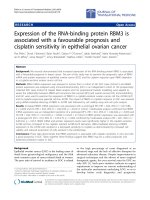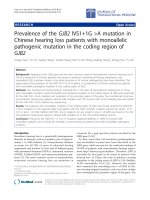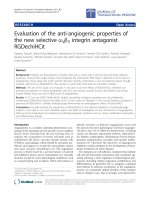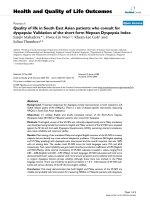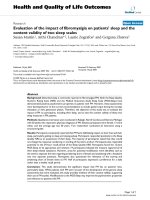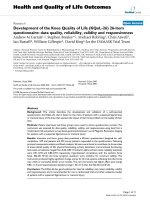Báo cáo hóa học: " Incidence of the V600K mutation among melanoma patients with BRAF mutations, and potential therapeutic response to the specific BRAF inhibitor PLX4032" potx
Bạn đang xem bản rút gọn của tài liệu. Xem và tải ngay bản đầy đủ của tài liệu tại đây (279.67 KB, 3 trang )
COMM E N T ARY Open Access
Incidence of the V600K mutation among
melanoma patients with BRAF mutations, and
potential therapeutic response to the specific
BRAF inhibitor PLX4032
Jill C Rubinstein
1
, Mario Sznol
2
, Anna C Pavlick
3
, Stephan Ariyan
4
, Elaine Cheng
5
, Antonella Bacchiocchi
5
,
Harriet M Kluger
2
, Deepak Narayan
4
, Ruth Halaban
5*
Abstract
Activating mutations in BRAF kinase are common in melanomas. Clinical trials with PLX4032, the mutant-BRAF inhi-
bitor, show promising preliminary results in patients selected for the presence of V600E mutation. However, activat-
ing V600K mutation is the other most common mutation, yet patients with this variant are currently excluded from
the PLX4032 trials. Here we present evidence that a patient bearing the BRAF V600K mutation responded remark-
ably to PLX4032, suggesting that clinical trials should include all patients with activating BRAF V600E/K mutations.
Commentary
BRAF is a serine/threonine protein kinase, encoded on
chromosome 7q34, that activates the MAP kinase/ERK-
signaling pathway (see KEGG Pathways Database).
Approximately 42% of melanomas harbor activating
BRAF mutations (see COSMIC Database, Wellcome
Sanger Trust). Most commonly, the valine at amino acid
600 is replaced by glutamate (V600E) through mutation
of a single nucleotide (GTG to GAG). Another known
mutation at this site involves two nucleotides (GTG to
AAG), substituting lysine for valine (V600K) (see Table
1 for statistics on the frequency of these mutations
reported in melanoma). The specific BRAF inhibitor
PLX4032 (Plexxikon Inc., Berkeley, CA) suppresses the
activated oncogenic pathway by inhibiting the ERK
kinase cascade. High objective response rates were
observed in the phase I clinical trial of PLX4032 in the
cohort of melanoma patients selected for tumors with
the V600E mutation, and ongoing phase II and phase III
clinical trials are limited to those patients with BRAF
V600E mutations [1].
The incidence of V600K mutations in melanoma may
be greater than previously assumed. In our series of 138
melanomas isolated from patients with disease of vary-
ing stage, 42 harbored BRAF mutations (determined by
Sanger dideoxy sequencing). Of these, 69% carried the
V600E mutation (15 h omozygous), while the remaining
28.6% carried the V600K variant (8 homozygous), and
one carried the V600R (AGG/AGG) mutation. Of note,
none of the samples are V600E/V600K heterozygotes,
meaning that the V600K mutation did not arise from a
second alteration at the site of an existing V600E. Alto-
gether, the combined studies show that BRAF V600K
mutations are present in 6-30% o f melanoma tumors
(Table 1). This broad range cannot be explained by var-
iation in the ratio of primary versus metastatic melano-
mas or by the different methods used for sequencing
(Table 1). Although different methods to detect the
mutation were used, most of the studies validated the
observations by Sanger dideoxy sequencing. Curiously,
the BRAF mutations present in about 84% of nevi are
reported to be of the V600E type [2,3]. Likewise, in our
cohort of 14 congenital nevi, we also detected four with
BRAF mutations, all heterozygous V600E. Therefore, it
is po ssible that t he V600E and V600K mutant melano-
mas arise from precursor lesions.
PLX4032 is a small molecule inhibitor targeting the
activated form of BRAF [4]. In our recent studies on the
effects of PLX4032, we demonstrated that the high
* Correspondence:
5
Department of Dermatology, Yale University School of Medicine, New
Haven, CT 06520, USA
Rubinstein et al. Journal of Translational Medicine 2010, 8:67
/>© 2010 Rubinstein et al; licensee BioMed Central Ltd. This is an O pen Access article distributed under the terms of the Creative
Commons Attribution License ( which permits unrestri cted use, distribution, and
reprodu ction in any me dium, provided the ori ginal work is properly cited.
enzymatic activity of both V600E and V600K BRAF
mutants in melanoma cells is suppressed by treatment
with PLX4032 [5]. PLX4032 is also known for its para-
doxical effect on cells with wild-type BRAF, in which
RAF1 is activated (reviewed in [ 6]). We showed that in
BRAF wild-type melanoma cells, PLX4032 stimulated the
downstream intracellular signaling pathway, causing cell
detachment and motility in metastatic melanoma cells
and enhancing cell proliferation in primary melanomas
carrying NRAS Q61L mutations. These paradoxical
effects highlight the importance of tailoring treatment to
the specific genetic composition of the tumor [5].
One of our patients with locally advanced unresectable
melanoma inv olving the skin of the l eft chest wall, pro-
gressing after treatment with topical imiquimod and sys-
temic temozolomide, was referred to another institution
for a phase II clinical trial of PLX4032. As part of the
eligibility requirements of the trial, paraffin-embedded
tissuefromabiopsyofacutaneouslesionwastested
and shown to be positive for the BRAF V600E mutation.
The patient was treated and achieved an excellent clini-
cal response to PLX4032, associated with substantial
reductioninthetumorburdenandpainfromthe
lesions. Figure 1 shows the cutaneous lesions before and
after treatment with PLX4032. A portion of the tumor
was also collected for laboratory research studies
according to a protocol approved by Yale University
Human Investigations Committee. Written informed
consent was obtained from the patient for publication of
this case report and accompanying i mages. A copy of
the written consent is available for review by the Editor-
in-Chief of this journal. Upon retesting for BRAF
Table 1 Incidence of V600 mutations in melanoma patients
Total V600
mutants
V600E
(%)
V600K
(%)
V600 D or
V600R (%)
Reference Assay
34 25 (73.5) 4 (11.8) 5 (14.7) Spittle et al. [7] Pyrosequencing,
validated by Sanger dideoxy sequencing
10 9 (90.0) 1 (10.0) 0 (0.0) Hay et al. [8] Melting point analysis, validated by Sanger dideoxy
sequencing
44 34 (77.3) 9 (20.5) 1 (2.3) Willmore-Payne et al. [9] Amplicon melting analysis, validated by Sanger
dideoxy sequencing
42 29 (69) 12 (28.6) 1 (2.3) Halaban et al. [5] and Halaban,
unpublished
Sanger dideoxy sequencing
50 47 (94.0) 3 (6.0) 0 (0.0) Ugurel et al. [10] Fluorescent capillary SSCP technique
178 143
(80.3)
29 (16.3) 6 (3.4) Total Mutations
Figure 1 Chest wall lesions before treatment with PLX4032 (A) and on the first day of the fifth treatment cycle (B).
Rubinstein et al. Journal of Translational Medicine 2010, 8:67
/>Page 2 of 3
mutation by Sanger dideoxy sequencing, it was shown
that in fact he carried the V600K allele (Figure 2, assay
repeated for validation).
Conclusions
Our data, and those of others reporte d in the literature,
indicate that the incidence of BRAF V600K mutations in
melanoma patients appears to be higher than is com-
monly assumed. It can be present in up to 30% of
patients bearing BRAF V600 mutations, potentially
representing up to 10% of all melanoma patients.
Patients with BRAF V600K mutations are currently
excluded from clinical trials with PLX4032, although the
assay methodology used for the trial may not discrimi-
nate between the V600E and V600K mutations. Our
preclinical data demonstrating s imilar kinase activity of
the V600K and V600E mutations, together with clear
evidence of clinical activity of PLX4032 in a patient with
a documented V600K mutation, suggest that melanoma
patients with V600K mutations should be included in
current and future trials of BRAF inhibitors.
Acknowledgements
This work was supported by the Yale SPORE in Skin Cancer funded by the
National Cancer Institute grant number 1 P50 CA121974 (R. Halaban, PI).
Written consent for publication was obtained from the patient.
Author details
1
Department of Pathology, Yale University School of Medicine, New Haven,
CT 06520, USA.
2
Section of Medical Oncology, Yale University School of
Medicine, New Haven, CT 06520, USA.
3
Department of Medical Oncology,
New York University, New York City, New York 10016, USA.
4
Plastic and
Reconstructive Surgery, Yale University School of Medicine, New Haven, CT
06520, USA.
5
Department of Dermatology, Yale University School of
Medicine, New Haven, CT 06520, USA.
Authors’ contributions
JR, compiled literature search and participated in writing the manuscript; MS
conceived the report and participated in writing the manuscript; ACP,
treated the patient with PLX4032; SA, excised tumors and provided the
material for research; EC, performed the BRAF mutation analysis; AB,
collected tumor material and established melanoma cells in culture; HMK,
participated in writing of the manuscript; DN, excised tumors and provided
the material for research; RH, in charge of analyzing tumor specimens and
participated in writing the manuscript. All authors have read and approved
the final manuscript.
Competing interests
The authors declare that they have no competing interests.
Received: 12 May 2010 Accepted: 14 July 2010 Published: 14 July 2010
References
1. Flaherty K, Puzanov I, Sosman J, Kim K, Ribas A, McArthur G, Lee RJ,
Grippo JF, Nolop K, Chapman P: Phase I study of PLX4032: Proof of
concept for V600E BRAF mutation as a therapeutic target in human
cancer. J Clin Oncol (Meeting Abstracts) 2009, 27:9000.
2. Uribe P, Wistuba I, González S: BRAF mutation: a frequent event in
benign, atypical, and malignant melanocytic lesions of the skin. Am J
Dermatopathol 2003, 25:365-370.
3. Poynter J, Elder J, Fullen D, Nair R, Soengas M, Johnson T, Redman B,
Thomas N, Gruber S: BRAF and NRAS mutations in melanoma and
melanocytic nevi. Melanoma Res 2006, 16:267-273.
4. Sala E, Mologni L, Truffa S, Gaetano C, Bollag G, Gambacorti-Passerini C:
BRAF silencing by short hairpin RNA or chemical blockade by PLX4032
leads to different responses in melanoma and thyroid carcinoma cells.
Mol Cancer Res 2008, 6:751-759.
5. Halaban R, Zhang W, Bacchiocchi A, Cheng E, Parisi F, Ariyan S,
Krauthammer M, McCusker J, Kluger Y, Sznol M: PLX4032, a selective BRAF
(V600E) kinase inhibitor, activates the ERK pathway and enhances cell
migration and proliferation of BRAF melanoma cells. Pigment Cell
Melanoma Res 2010, 23:190-200.
6. Pratilas C, Solit D: Targeting the MAPK Pathway: Physiological Feedback
and Drug Response. Clin Cancer Res 2010, 16:3329-34.
7. Spittle C, Ward M, Nathanson K, Gimotty P, Rappaport E, Brose M,
Medina A, Letrero R, Herlyn M, Edwards R: Application of a BRAF
pyrosequencing assay for mutation detection and copy number analysis
in malignant melanoma. J Mol Diagn 2007, 9:464-471.
8. Hay R, MacRae E, Barber D, Khalil M, Demetrick D: BRAF mutations in
melanocytic lesions and papillary thyroid carcinoma samples identified
using melting curve analysis of polymerase chain reaction products.
Arch Pathol Lab Med 2007, 131:1361-1367.
9. Willmore-Payne C, Holden J, Tripp S, Layfield L: Human malignant
melanoma: detection of BRAF- and c-kit-activating mutations by high-
resolution amplicon melting analysis. Hum Pathol 2005, 36:486-493.
10. Ugurel S, Thirumaran R, Bloethner S, Gast A, Sucker A, Mueller-Berghaus J,
Rittgen W, Hemminki K, Becker J, Kumar R, Schadendorf D: B-RAF and N-
RAS mutations are preserved during short time in vitro propagation and
differentially impact prognosis. PLoS One 2007, 2:e236.
doi:10.1186/1479-5876-8-67
Cite this article as: Rubinstein et al.: Incidence of the V600K mutation
among melanoma patients with BRAF mutations, and potential
therapeutic response to the specific BRAF inhibitor PLX4032. Journal of
Translational Medicine 2010 8:67.
Figure 2 Electropherogram from Sanger dideoxy sequencing showing the patient’ s melanoma tumor BRAF codon 600 mutation
(AAG/GTG), encoding V600K/WT protein.
Rubinstein et al. Journal of Translational Medicine 2010, 8:67
/>Page 3 of 3




